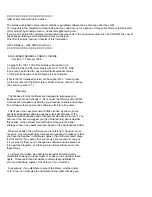
5 Support and Other Resources
New and Changed Information in This Edition
The eighth edition of HP-UX System Administrator's Guide: Logical Volume Management addresses
the following new topics:
•
Added information about converting cDSFs back to their corresponding persistent DSFs, in
Table 5 (page 39)
.
•
Provided new information on LVM I/O timeout parameters, see
“Configuring LVM I/O Timeout
Parameters” (page 33)
and
“LVM I/O Timeout Parameters” (page 161)
.
•
Added error message information for
vgmodify
in
“Warning and Error Messages” (page 163)
.
•
Added error message and recommendation for failure in deletion of snapshot logical volume
device, see
“Warning and Error Messages” (page 163)
.
About this Series
The HP-UX System Administrator’s Guide documents the core set of tasks (and associated concepts)
necessary to administer systems running HP-UX 11i Version 3.
The HP-UX System Administrator’s Guide is a set of documents comprised of the following volumes:
Overview
Provides a high-level view of HP-UX 11i, its components,
and how they relate to each other.
Configuration Management
Describes many of the tasks you must perform to configure
and customize system settings and the behavior of
subsystems.
Logical Volume Management
Documents how to configure physical volumes, volume
groups, and logical volumes using the HP Logical Volume
Manager (LVM).
Security Management
Documents the data and system security features of HP-UX
11i.
Routine Management Tasks
Documents many of the ongoing tasks you must perform to
keep your system running smoothly.
Typographic Conventions
This document uses the following typographical conventions:
%
,
$
, or
#
A percent sign represents the C shell system prompt. A dollar
sign represents the system prompt for the Bourne, Korn, and
POSIX shells. A number sign represents the superuser prompt.
audit(5)
A manpage. The manpage name is audit, and it is located
in Section 5.
Command
A command name or qualified command phrase.
Computer output
Text displayed by the computer.
Ctrl+x
A key sequence. A sequence such as
Ctrl+x
indicates that
you must hold down the key labeled
Ctrl
while you press
another key or mouse button.
Document Title
The title of a document. On the web and on the Instant
Information media, it may be a hot link to the document itself.
ENVIRONMENT VARIABLE
The name of an environment variable, for example,
PATH
.
ERROR NAME
The name of an error, usually returned in the
errno
variable.
New and Changed Information in This Edition
141
















































